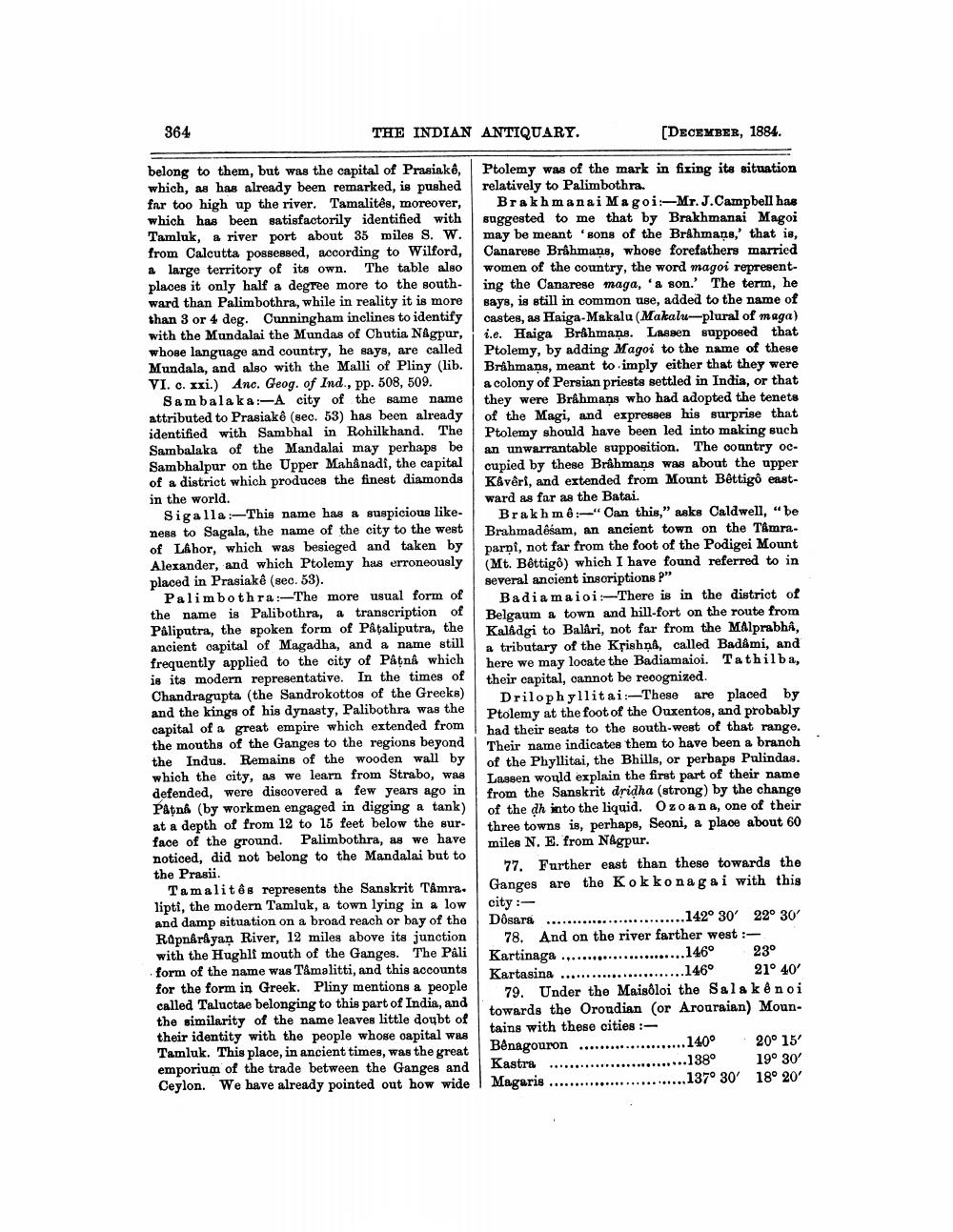________________
364
THE INDIAN ANTIQUARY.
belong to them, but was the capital of Prasiakê, which, as has already been remarked, is pushed far too high up the river. Tamalitês, moreover, which has been satisfactorily identified with Tamluk, a river port about 35 miles S. W. from Calcutta possessed, according to Wilford, a large territory of its own. The table also places it only half a degree more to the southward than Palimbothra, while in reality it is more than 3 or 4 deg. Cunningham inclines to identify with the Mundalai the Mundas of Chutia Nagpur, whose language and country, he says, are called Mundala, and also with the Malli of Pliny (lib. VI. c. xxi.) Anc. Geog. of Ind., pp. 508, 509.
Sambalaka:-A city of the same name. attributed to Prasiakê (sec. 53) has been already identified with Sambhal in Rohilkhand. The Sambalaka of the Mandalai may perhaps be Sambhalpur on the Upper Mahanadi, the capital of a district which produces the finest diamonds in the world.
Sigalla-This name has a suspicious likeness to Sagala, the name of the city to the west of Lahor, which was besieged and taken by Alexander, and which Ptolemy has erroneously placed in Prasiakê (sec. 53).
Palimbothra:-The more usual form of the name is Palibothra, a transcription of Pâliputra, the spoken form of Pâtaliputra, the ancient capital of Magadha, and a name still frequently applied to the city of Pâtna which is its modern representative. In the times of Chandragupta (the Sandrokottos of the Greeks) and the kings of his dynasty, Palibothra was the capital of a great empire which extended from the mouths of the Ganges to the regions beyond the Indus. Remains of the wooden wall by which the city, as we learn from Strabo, was defended, were discovered a few years ago in Patna (by workmen engaged in digging a tank) at a depth of from 12 to 15 feet below the surface of the ground. Palimbothra, as we have noticed, did not belong to the Mandalai but to the Prasii.
Tamalitês represents the Sanskrit Tâmra. lipti, the modern Tamluk, a town lying in a low and damp situation on a broad reach or bay of the Rapnarayan River, 12 miles above its junction with the Hughlf mouth of the Ganges. The Pâli form of the name was Tâmalitti, and this accounts for the form in Greek. Pliny mentions a people called Taluctae belonging to this part of India, and the similarity of the name leaves little doubt of their identity with the people whose capital was Tamluk. This place, in ancient times, was the great emporium of the trade between the Ganges and Ceylon. We have already pointed out how wide
[DECEMBER, 1884.
Ptolemy was of the mark in fixing its situation relatively to Palimbothra.
Brakhmanai Magoi-Mr. J.Campbell has suggested to me that by Brakhmanai Magoi may be meant 'sons of the Brahmans,' that is, Canarese Brahmans, whose forefathers married women of the country, the word magoi representing the Canarese maga, a son.' The term, he says, is still in common use, added to the name of castes, as Haiga-Makalu (Makalu-plural of maga) i.e. Haiga Brâåhmans. Lassen supposed that Ptolemy, by adding Magoi to the name of these Brahmans, meant to imply either that they were a colony of Persian priests settled in India, or that they were Brahmans who had adopted the tenets of the Magi, and expresses his surprise that Ptolemy should have been led into making such an unwarrantable supposition. The country occupied by these Brahmans was about the upper Kêvêri, and extended from Mount Bêttigo eastward as far as the Batai.
Brakhmê:"Can this," asks Caldwell, "be Brahmadêsam, an ancient town on the Tâmraparpi, not far from the foot of the Podigei Mount (Mt. Bêttigo) which I have found referred to in several ancient inscriptions ?"
Badia maioi:-There is in the district of Belgaum a town and hill-fort on the route from Kalâdgi to Balâri, not far from the Målprabhâ, a tributary of the Krishna, called Badâmi, and here we may locate the Badiamaioi. Tathilba, their capital, cannot be recognized.
Drilophyllitai:-These are placed by Ptolemy at the foot of the Ouxentos, and probably had their seats to the south-west of that range. Their name indicates them to have been a branch of the Phyllitai, the Bhills, or perhaps Pulindas. Lassen would explain the first part of their name from the Sanskrit dridha (strong) by the change of the dh into the liquid. Ozoan a, one of their three towns is, perhaps, Seoni, a place about 60 miles N. E. from Nagpur.
77. Further east than these towards the Ganges are the Kokko nagai with this city:
............
Dôsara ...142° 30' 22° 30' 78. And on the river farther west :Kartinaga.... 23° ............................................................146° Kartasina.... ..146° 21° 40' 79. Under the Maisðloi the Salakenoi towards the Oroudian (or Arouraian) Mountains with these cities:
**********
Bênagouron Kastra Magaris
************
..140° .138°
..137° 30'
20° 15'
19° 30' 18° 20'




